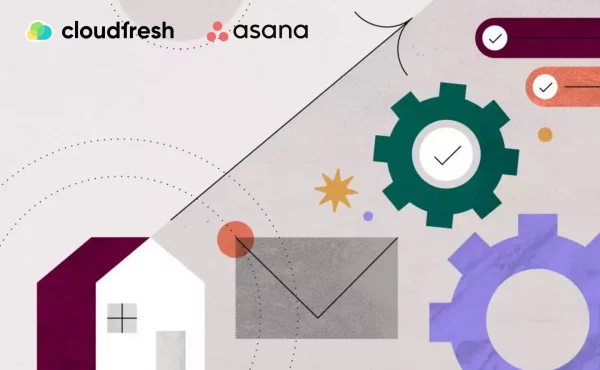8 Useful Tips for Using Asana
Asana and Hubspot Integration: how the company uses the platform for project management
When a company is actively growing and expanding its departments, the project management process becomes increasingly difficult to align. In today’s reality with a hybrid work model, employees increasingly need appropriate tools to work and interact with other projects. If such a tool is not available, about 60% of work time is spent coordinating different tasks, i.e., updating statuses, creating a summary of the latest updates or gathering information about current projects.
Setting up all the workflows in a remote environment is no easy task. Asana has helped take HubSpot to the next level, while improving the company’s cross-functional collaboration.
Does Asana integrate with HubSpot?
Yes, Asana offers a native integration with HubSpot, allowing you to:
- Sync contacts and leads: Streamline communication by keeping Asana and HubSpot data in sync.
- Convert HubSpot deals to Asana projects: Streamline workflows by automatically turning deals into actionable project tasks.
- Track time spent on tasks: Gain insights into project efficiency by linking time spent in Asana to relevant HubSpot deals.
This integration helps bridge the gap between marketing and sales teams, facilitating smoother project management and collaboration.
Navi Singh, HubSpot’s general project manager, shares her experience with us and talks about the improvements the company has seen since implementing Asana. According to Navi, an organization needs a tool or platform to work with such as Asana in order for teamwork to be consistent and continuously scalable.
How HubSpot realized that they needed a new platform to operate
Before HubSpot started using Asana, the team communicated on different messengers and used different tools for work. The result was a completely different view of workflow and uncoordinated work on the same project. The lack of consistency hindered the team’s productivity and led to an increase in unnecessary work.
At the moment of realizing the problem, the issue of finding a project management platform that multiple departments can interact with at once became urgent.
It was important to provide employees with an application that could quickly respond to requests and provide them with the information they needed on projects.
That’s when the team started using Asana. The marketing department was the first to use the platform, but soon the technical departments began to use it as well. Navi Singh recalls his first impressions: “If Asana helps us so much without proper integration, what could it do if we had prepared for its implementation thoroughly?” Today, the company is still transitioning to working with Asana department by department, from event management to company-wide.
How the implementation of Asana began
The marketing department was the first to use Asana. Employees were used to keeping all of the information in an easy way to access, simplifying and streamlining their workflow. It was also important to decide how to share information about progress with other stakeholders outside the department.
The solution was the Universal Reporting tool, a feature that allows you to offload data from the platform in minutes and present it to management or present it as analytics. This feature gives a different perspective on numbers and information from different projects.
What HubSpot will use Asana for in the future
HubSpot has just begun using Asana for project management. In the near future, the goal is to implement the platform in all departments where work can be optimized. At the moment, the team’s goal is to find weaknesses in the work and start using the following features:
- Automatically add labels or tickets to task cards for full understanding of work steps;
- Optimization and transfer of all work communication to the platform;
- Ability to display all relevant project information in a single report.
Is it possible to do all this with Asana? Definitely yes. Navi says that already all the workflows of the company’s marketing department have been fully migrated to Asana, which has simplified interaction with other departments.
“Now we can easily lead a project from start to delivery without losing information and with the confidence that the right people will connect at the right time.”
The company has also started actively implementing new features from the platform, called Asana Workflow. You can learn more about the new update of the application by following this link.
Diving Deep Into Asana – Hubspot Integration
Asana and HubSpot are powerful platforms in their respective categories – project management and CRM. But thoughtfully integrating them takes efficiency to the next level by streamlining cross-functional workflows.
Siloed teams and systems lead to friction through manual coordination and communication overhead. According to research by Accenture, 37% of employee time gets wasted due to poor process integration.
Integrating core business platforms like Asana and HubSpot eliminates these inefficiencies by enabling:
- End-to-end workflow automation
- Real-time cross-team coordination
- Single source of truth across systems
- Unified analytics and insights
HubSpot – Asana integration enhances enterprise agility, visibility, and scale.
Asana centers around flexible project management techniques with features like:
- Kanban boards to visualize workflows
- Custom fields and views to track project metadata
- Automated and recurring tasks with dependencies
- Robust API and 140+ app integrations
Asana enables both agile and waterfall approaches to systematically plan and manage everything from strategic initiatives to routine tasks.
HubSpot empowers businesses across four key customer lifecycle stages:
- Attract – Generating inbound leads through blogging, SEO, email, social media
- Convert – Turning leads into customers with landing pages, forms, live chat
- Close – Managing the sales process through the CRM, quotes, proposals
- Delight – Providing ongoing support through ticketing, knowledge base, surveys
The platform consolidates formerly disjointed systems into a centralized and automated CRM system.
Asana and HubSpot offer robust integration capabilities:
Configuration Options
- Installing Asana app in HubSpot marketplace
- Two-way sync between tasks and deals/tickets
- Mirroring Asana task statuses to HubSpot deal stages
- Automatic task creation from deal creation/updates
According to Asana, customers leveraging integrations complete work 2.5 times faster.
Maximizing the Potential Across Teams
Connected Asana and HubSpot workflows unlock new efficiencies:
- Sales can turn quotes into project plans with one click
- Support tickets get routed to correct teams and create tasks automatically
- Marketing campaign launches can spawn all associated project tasks
- Engineering updates on progress flow through directly to connected deals and tickets
Removing cross-functional friction results in greater speed, transparency, and agility across the organization.
Best Practices for HubSpot – Asana Implementation
To maximize the impact of Asana-HubSpot integration:
- Start with specific high-value workflows rather than everything at once
- Structure projects, tasks, and deals/tickets to reflect organizational processes
- Map interdependent deals and tasks to surface connections
- Use bi-directional sync cautiously to avoid notification noise
- Take change management seriously when rolling out to drive adoption
With a thoughtful rollout focused on streamlining critical cross-functional workflows, the integration drives rapid productivity gains.
With digital transformation accelerating, integrating core platforms is becoming imperative to unlock enterprise agility. Asana and HubSpot integration demonstrates the massive productivity potential of connected systems.
Forward-thinking organizations must prioritize platform integration capabilities in technology selection and ecosystem architecture decisions. The future of work will be defined by tools and technologies that eliminate friction through intelligent automation.
You can find out more about the new features, as well as about connecting and implementing Asana from Cloudfresh specialists. The Cloudfresh team is a unique center of expertise for Google Cloud, Zendesk, and Asana. For these products, we can provide you with the following services:
- Customization;
- Development;
- Integration;
- Training;
- License;
- Support.
Our Asana consultants will help you optimize your IT infrastructure, develop integrations for better system interoperability, and help create completely new structures and processes for your teams, while our support center will provide you with the best customer experience!











